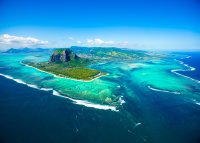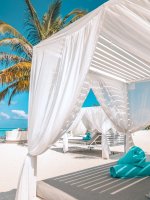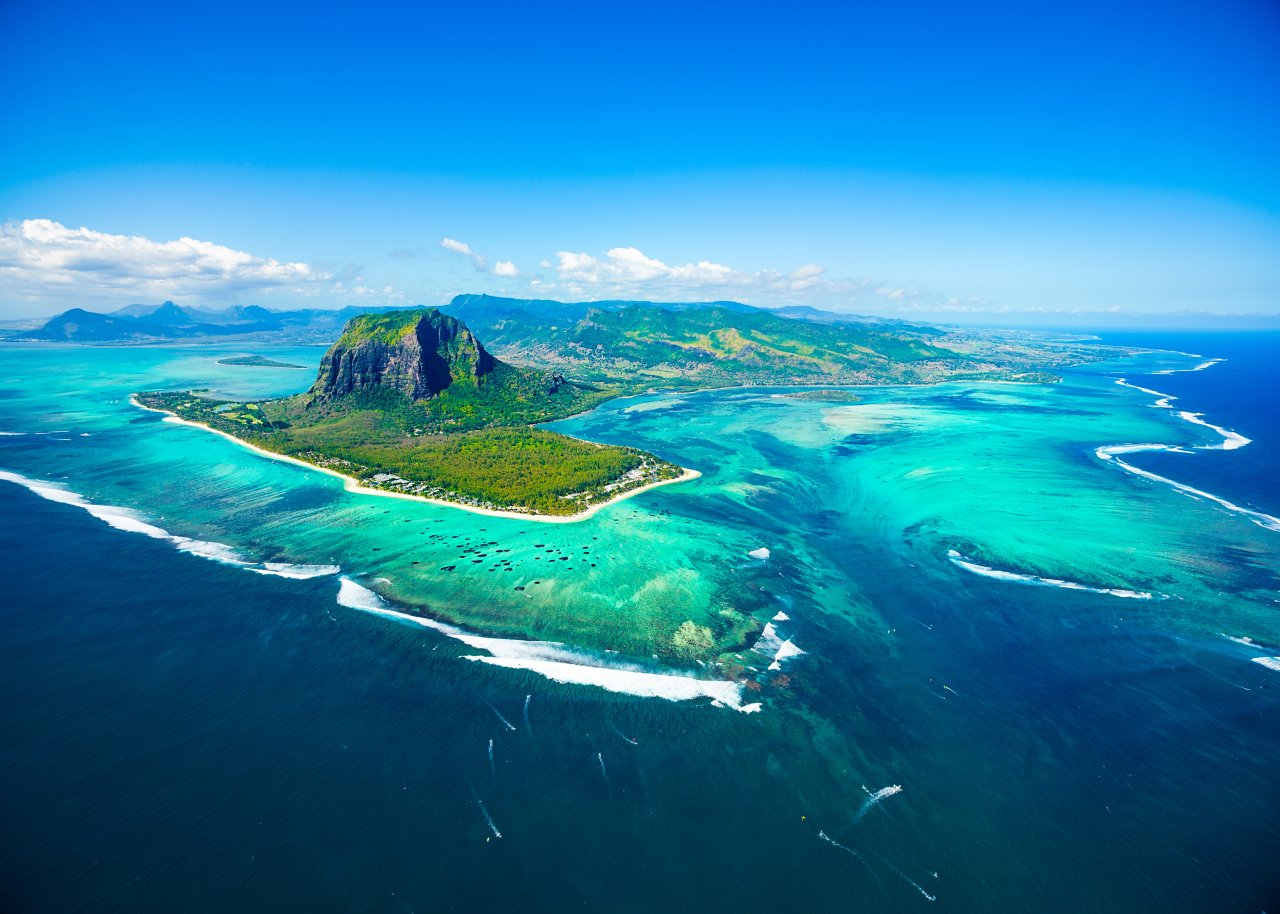SIR SEEWOOSAGUR RAMGOOLAM BOTANIC GARDENS (Pamplemousses; % 243 9401; gardens ( 08.30–17.30 daily; admission Rs250) Formerly known as the Royal Botanic Garden, this is one of the island’s most popular tourist attractions, located 11km northeast of Port Louis. Most hotels and travel agents offer tours to the gardens and they are easily accessible from Port Louis by bus from the Immigration Square bus station or from Grand Baie (bus route 216). There are also buses from the coastal towns of the north. Buses stop on the main road and the garden is a five-minute walk away. On Sundays it is popular with picnickers.
The garden covers 60 acres so a guide or good map is essential to get the most out of it. Official guides (with a badge) are available (for a small fee) by the main gate and the entrance from the car park. It is by no means obligatory to have a guide and their sales pitch can sometimes be rather pushy. Unofficial guides (no badge) operate within the garden and may approach you. The booths at the main gates, which are only open on weekdays, sell comprehensive guidebooks on the gardens (Rs225) but the leaflets, which have a good map, are sufficient to find your way around.
The fence and gates at the entrance are scrolled in wrought iron and gained a first prize in the International Exhibition at London’s Crystal Palace in 1862. The gate was a gift from François Liénard, a Frenchman, born in India in 1783, who lived in Mauritius. There is a memorial obelisk to him in the garden.
The garden’s origins go back to 1729 when a French colonist acquired about half the present site, then called Mon Plaisir. Mahé de Labourdonnais bought it in 1735 and created a vegetable garden (to the left of the present main entrance) beside his own residence, Château de Mon Plaisir, to supply vegetables to his household, the town and visiting ships. The garden was also used as a nursery for plants imported from Europe, Asia and South America. Mulberry bushes were planted in the hope of starting a silkworm industry but were replaced by bois noir (Albizia lebbeck), to be turned into charcoal for use in the manufacture of gunpowder for the island’s defence.
When, in 1770, the garden became the private property of Pierre Poivre, administrator of the island, Pamplemousses flourished. He cultivated spices such as nutmeg and cloves, as well as ornamental trees. In 1810, the garden reverted to government ownership and was neglected by the British until James Duncan was appointed director in 1849. He introduced many of the palms including the royal palms (Roystonea regia and Roystonea oleracea), which add a majestic splendour to the main avenue. Thousands of eucalyptus trees were planted in the garden after the malaria epidemic of 1866, for transplanting in swamps to dry them out and reduce mosquito-breeding grounds. Since 1913 the garden has been under the control of the Ministry of Agriculture.
Today the garden boasts 500 species of plant, of which 80 are palms and 25 are indigenous to the Mascarene Islands. The numerous highlights include the impressive giant water lilies (Victoria amazonica), which float like giant baking tins in a rectangular pond. Their flowers open for two days only, from the late afternoon to the following morning. On the first day they are cream-coloured with a heady fragrance, on the second they are pink. Another pond contains the white and yellow flowers of the lotus (Nelumbo nucifera), which is held in veneration by Hindus. The betel nut palm (Areca cathecu) grows nearby. Its orange fruit contains the betel nut which is sliced, mixed with lime paste, wrapped in the leaf of the vine (Piper betel) and chewed. It’s a cancer-causing stimulant which depresses the appetite and stains the gums and lips an alarming red. The talipot palms (Corypha umbraculifera) are said to flower once every 40 to 60 years with
over 50 million tiny blooms, reaching a height of 6m above the tree. After waiting so long to flower just once, the tree dies.
The Château de Mon Plaisir looks impressive but lightweight, perhaps because it is not the original home of Labourdonnais but an English-built office mansion, now used for administration and exhibitions. The nearby sugar mill is also a reconstruction. Former prime minister and governor general Sir Seewoosagur Ramgoolam was cremated outside the mansion and his ashes scattered on the Ganges, in India. In front of the chateau are trees planted by visiting royal and political dignitaries, such as Nelson Mandela.
The tortoise pen houses Aldabra tortoises, first brought to the gardens in 1875 from Aldabra Island to protect them from being wiped out by seabirds (when young) or being eaten by humans (when older). The stag park contains the Cervus timorensis russa deer, first introduced in 1639 from Batavia.
Animals to be seen at liberty include the indigenous fruit bat (Pteropus niger), two species of rat (the brown Norway rat and the black arboreal Asiatic rat), and the Madagascar tenrec (Centetes spp.). The large, black butterfly with blue windows on its wings is the Papilio manlius.
Indigenous birds include the moorhen (Gallinula chloropus pyrrhorrhoa), with its red bill, and the green-backed heron (Butorides striatus rutenbergi). The small greyish bird in groups with a ‘tip-tip-tip’ call is l’oiseau Manioc (Malacirops borbonicus mauritianus). Species of the Phelsuma lizard may be seen on palm trees.
There are several monuments in the garden including a stone slab which the sentimental believe marks the grave of the fictitious lovers, Paul and Virginie. Their creator, Bernadin de St Pierre, is remembered with a bust.
L’AVENTURE DU SUCRE (Beau Plan, Pamplemousses; % 243 7900; f 243 9699; e aventure.sucre[at]intnet.mu; aventuredusucre.com; ( 09.00–17.00 daily;admission adult/child Rs350/175) In 1999, the Beau Plan sugar factory, which had been operating since 1895, closed down. In October 2002, it was converted into a fascinating high-tech museum covering the history of sugar, the history of Mauritius and the process of sugar production. The exhibits on slavery and the treatment of slaves and runaways are particularly thought-provoking. In fact, the museum provides one of the most comprehensive and digestible histories of Mauritius available on the island. The visit culminates in a tasting of export-quality sugars and rums. Sugar products and other souvenirs are on sale at the shop. Allow approximately two hours for self-guided tours, including tasting. There is a restaurant, Le Fangourin, which serves delicious meals and special sugar desserts
ChAteau de Labourdonnais (Mapou; % 266 9533; f 266 6415; unchateaudanslanature.com; ( 09.00–17.00 daily; admission adult/child Rs350/175)A Creole mansion built in 1859 at the heart of an agricultural estate. A private home until 2006, the house had fallen into disrepair but was carefully restored and opened to visitors in 2010. Although some French experts were called in, much of the restoration work was done by local artisans, including the wonderful metal railings along the veranda. A video tells the fascinating story of the restoration and audio in the various rooms reflecting family life (currently only in French) brings the place alive. The wallpaper in the dining room, which features countryside scenes of deer and birds in a forest, is the original, painstakingly restored. There is no disabled access but disabled guests can view a virtual tour on a screen on the ground floor. You cannot wear high-heeled shoes or take photographs in the chateau. After visiting the house you can explore the 150-year-old orchards and at the end of the tour you can taste fruit juice, rum and fruit jelly made on the estate. There is a modern restaurant in the grounds a shop and a few tortoises in a pen.
MAURITIUS AQUARIUM (Coastal Rd, Pointe aux Piments; % 261 4561; f 261 5080; e info[at]mauritiusaquarium.com; mauritiusaquarium.com; ( 09.30–17.00 Mon–Sat, 10.00–15.00 Sun & public holidays; admission adult/child/family (2 adults, 2 children) Rs250/125/650) Opened in 2004, the aquarium has filled an important gap in the island’s attractions. It is small but thoughtfully designed and offers a good opportunity to see some of the creatures you’ll observe while snorkelling or diving off Mauritius, except in the aquarium they have handy labels. Favourites include the Picasso triggerfish (Rhinecanthus aculeatus), Moorish idol (Zanclus cornutus), domino fish (Dascyllus aranus), white tip reef sharks (Triaenodon obesus) and green sea turtles (Chelonia mydas). There are freshwater fish too, such as the carp caught locally by the manager. Children will enjoy the touch pool. There is a small souvenir shop and snack bar. The fish are fed daily at 11.00.















